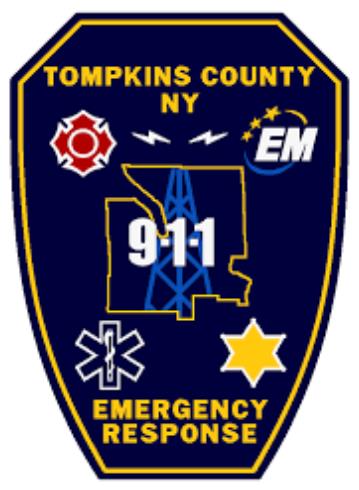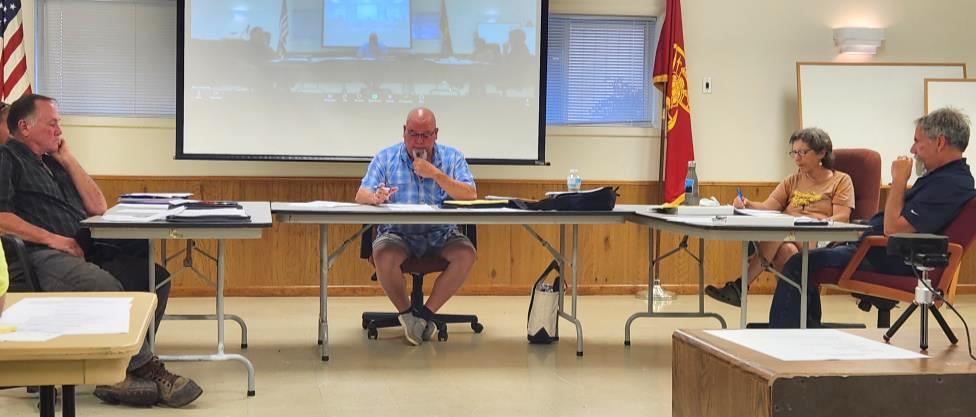by Robert Lynch; July 23, 2024
How well did Enfield and Tompkins County cope with the sudden, violent mid-July windstorm that downed countless trees, snapped more than a score of electric poles and left thousands locally without power, some for days? It may depend upon whom you ask and what questions you pose.

“We did an excellent job last night,.” Enfield Volunteer Fire Company (EVFC) President Dennis Hubbell informed Enfield’s Board of Fire Commissioners Tuesday evening, July 16th, about 24 hours after his volunteers had swung into action after the high winds and rain tore through his town.
“I want to extend my thanks and gratitude for the exemplary performance demonstrated by our 911 Center personnel,” John Halaychik, Assistant Director-911 at the Tompkins County Department of Emergency Response stated in a news release July 18th. He said dispatchers at Tompkins County’s Emergency Communications Center handled 455 calls for service within the county during the severe weather event that began late that Monday and lasted for the next two days.
“I believe the 455 calls for service is the highest single-day volume we’ve experienced in the last 10 years, if not ever,” Halaychik said.
No one in Tompkins County died from the storm. There were no reported injuries. A few freezers and refrigerators of spoiled food became the event’s principal casualties. But lessons were learned. And for those wise enough to heed them, they deserve to be remembered.
The P.R-sanitized message from Tompkins County government that week stood somewhat in contrast with what Fire Commissioners heard in Enfield that Tuesday night, as power for many remained out.
The Tompkins County view: “The way situations, communications, and notifications were made and handled was top notch,” Assistant Director Halaychik stated in his department’s news release. “Everyone involved is to be commended for their professionalism and actions, both in the 911 Center and those first responder personnel in the field, who—in their feedback to us—were extremely grateful of the effort and coordination.”
The Enfield view: “When we tried to report lines down last night, they told us we’re no longer taking calls,” Enfield Fire Chief Jamie Stevens told the Board of Fire Commissioners.

Chief Stevens related to this writer that the Call Center got overwhelmed and told fire departments to stand in place in their respective stations and answer calls for their community as they saw needed. The Call Center relied on the “CAD System,” a computerized notification program. Operators would post to the CAD System, and departments could use that resource to respond.
But in Enfield, there was a problem. For reasons that Chief Stevens never completely explained during the Commissioners meeting, EVFC volunteers are presently unable to fully and properly receive CAD messages at the fire station. The night of the storm, Fire Chief Stevens said, an EVFC volunteer who also serves the Ithaca Fire Department had to view CAD from his downtown vantage point, photograph its messages on his phone, and then relay them to Enfield’s fire house.
Without using the exact words, Stevens said such a jerry-rigged notification practice is unacceptable to him. What he needs, the Enfield Fire Chief said, is a large-screen monitor and a computer specifically dedicated to the CAD system. A simple, cheap fix, it would seem, albeit a necessary one.
Armed with Stevens’ newly-disclosed request, this Town Councilperson related it to the Enfield Town Board the following night. I asked whether any remaining funds from the federally-backed American Rescue Plan (ARPA) could be spent for the purpose. Town Supervisor Stephanie Redmond informed us that the last bit of ARPA money had already been spent in renovating the Town Clerk’s office.
What about the 911 Call Center’s overwhelming number of calls? Enfield Fire Commissioners were told it’s the third time that’s happened this year.
“The radio traffic is what overwhelmed them,” Company President Hubbell said of the bottleneck that confronted those at the 911 Call Center. “Some fire departments, all they want to do is talk,” Hubbell complained, clearly referring to other emergency crews in the county. “They want to talk about what color the trees are.”
Part of the reason Chief Stevens and President Hubbell said the things they said was to encourage set-asides in the next Enfield Fire District budget for the extra equipment that would make the volunteer response quicker and keep Enfield safer.
Board of Fire Commissioners Chair Greg Stevenson had a better idea: Encourage Tompkins County to pony-up.
“We should push the County to do as much as they can do.” Chairman Stevenson said.
Greg Stevenson, a former Tompkins County legislator and Enfield Fire Chief, also had operational criticism of the County-run dispatch system. It’s not the way it used to be, the Board Chair told the meeting. The people are different.

“Now it’s a civil service job,” Stevenson remarked. All you need to do is pass a typing test. “You don’t know the system.”
“In the past, fire dispatchers were mostly fire company members (not necessarily Enfield members, but local fire service experienced folks),” Stevenson wrote in an email to this writer July 17th, expanding on his meeting remarks. “Now, with the combination of many emergency services agencies being dispatched from the 911 center, that fire service familiarity is sometimes there and sometimes not.”
The Monday afternoon storm left as many as 5,992 customers in the Ithaca area without power, T.F. Winderl, the designated spokesperson for NYSEG’s Ithaca Division, stated during a conference call with local municipal officials July 16th. By one day later, the outages had been reduced to just over 1,000. Power to most people was back on by Wednesday night of that week.
And also by that Wednesday, NYSEG had made bottled water and dry ice available to those who wanted it. Supervisor Redmond obtained a supply of those materials and offered to distribute them to Enfield residents during and before the Town Board’s meeting Wednesday evening. After the two-hour session had ended, Redmond reported one or two people had come for the bottled water. No one had requested the dry ice.
###

